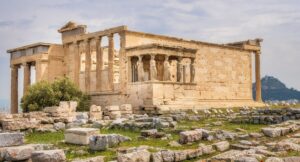Table of Contents
ToggleIntroduction
Among the Seven Wonders of the Ancient World, the Mausoleum at Halicarnassus stands as a testament to the enduring power of love and remembrance. Built as a grand tomb for Mausolus, the ruler of Caria, and his beloved wife Artemisia, this architectural masterpiece captivates with its magnificence and intricate details. In this blog, we embark on a journey to explore the historical significance, architectural marvels, artistic splendor, and the poignant story behind the Mausoleum at Halicarnassus.
Halicarnassus: A City of Legend
We begin by delving into the history and cultural significance of Halicarnassus, the ancient city in Caria where the mausoleum was built. We uncover the city’s rise to prominence, its strategic location, and the influence of Mausolus and Artemisia on its development.
Mausolus and Artemisia: A Tale of Love and Power
The story of Mausolus and Artemisia is one filled with love, devotion, and shared rule. We explore their reign, their love for each other, and their vision for the mausoleum as a testament to their eternal bond.
The Mausoleum's Architecture and Design
We delve into the architectural marvels of the Mausoleum at Halicarnassus, examining its design, layout, and unique features. We explore the fusion of architectural styles, the use of marble, and the intricate sculptures and reliefs that adorned the structure.
The Mausoleum's Sculptures and Artistic Beauty
The mausoleum boasted an impressive array of sculptures and artistic embellishments. We discuss the renowned sculptors who contributed to its creation and highlight the exquisite details that adorned the exterior and interior, including friezes, statues, and decorative elements.
Historical Accounts and Descriptions
Although the mausoleum no longer stands today, we rely on historical accounts and descriptions to reconstruct its grandeur. We examine the writings of ancient authors and historians who documented the mausoleum, providing valuable insights into its appearance and significance.
Destruction and Excavation
We delve into the eventual destruction of the mausoleum, caused by earthquakes and human interference over the centuries. We explore the efforts of archaeologists and historians to excavate and preserve the remains, uncovering fascinating artifacts and shedding light on the mausoleum’s past.
Legacy and Influence
The Mausoleum at Halicarnassus left a lasting impact on architectural styles and commemorative structures. We explore its influence on subsequent tombs and mausoleums, its impact on the development of Hellenistic architecture, and its significance in the broader context of ancient funerary art.
Modern Perspectives and Preservation
Today, the legacy of the Mausoleum at Halicarnassus continues to inspire awe and admiration. We discuss the efforts made to preserve its memory and the challenges faced in protecting and displaying its remains in modern-day Bodrum, Turkey.
Rumor
The Mausoleum at Halicarnassus, like many ancient wonders, has been shrouded in mystery and rumors throughout history. Here are a few intriguing rumors associated with the mausoleum:
- Hidden Treasure: One rumor suggests that the Mausoleum at Halicarnassus was not only a grand tomb but also a repository of hidden treasures. According to the legend, Mausolus and Artemisia had amassed a vast fortune, which they concealed within the structure. However, no concrete evidence has ever surfaced to support this claim, and it remains purely speculative.
- Curse of the Mausoleum: Another rumor that has circulated over the years involves a supposed curse associated with the mausoleum. It is said that disturbing or desecrating the tomb would bring about misfortune, tragedy, or even death to those involved. This rumor likely stems from the belief in curses associated with ancient tombs and serves to add an aura of mystery and caution to the mausoleum’s legacy.
- Secret Passageways: There have been rumors of secret passageways or hidden chambers within the Mausoleum at Halicarnassus. According to these rumors, these passages were used for various purposes, such as hiding valuable artifacts or providing access to the tomb. While there is no concrete evidence to substantiate these claims, the idea of hidden chambers adds an element of intrigue and fascination to the mausoleum.
It’s important to note that these rumors are often based on speculation, legends, and the fertile imaginations of storytellers throughout history. While they may add an element of mystery and allure to the Mausoleum at Halicarnassus, it’s essential to approach them with skepticism and rely on verified historical accounts and archaeological evidence to gain a clearer understanding of the mausoleum’s true nature.
Conclusion
The Mausoleum at Halicarnassus stands as a testament to the power of love, beauty, and the human desire for immortality. Though the physical structure may be lost to time, its story and influence live on. The mausoleum’s architectural splendor, artistic achievements, and the poignant tale of Mausolus and Artemisia remind us of the enduring power of remembrance and the profound impact that love and legacy can have on shaping the course of history.



